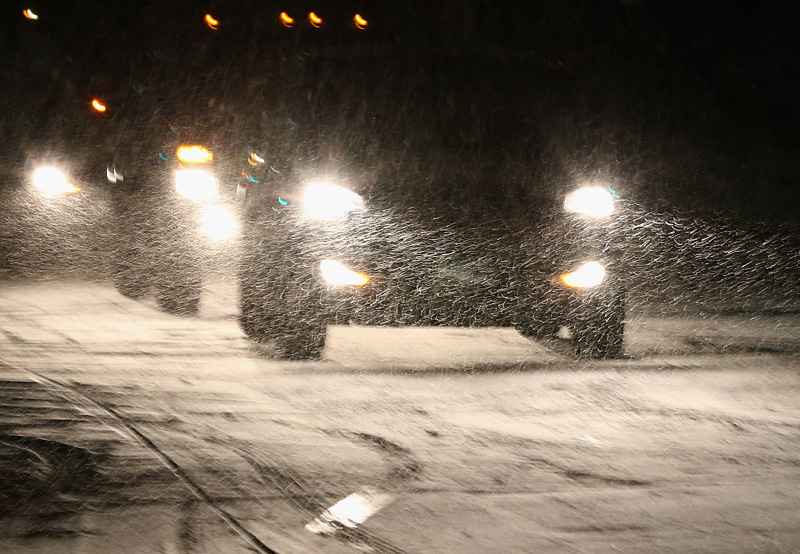Winter driving is messy and can be dangerous.

It’s an old problem, solved, at least most of the time, with scrapers and wiper fluid.
But driving on a slushy winter road in Michigan, automotive writer and consultant Sam Abuelsamid found that it has a new set of consequences.
Testing a Hyundai Sonata, Abuelsamid drove until road slush on a messy winter day blinded the adaptive cruise control, which is supposed to regulate the car’s spacing from the car ahead of it. It needs sensors to see, but the sensors need to be able to see.
“After about 15 minutes of driving using the adaptive cruise control, the radar sensor on the front of the car had a layer of slush that it could not see through,” he says. “It disengaged the adaptive cruise control and put up an alert in the instrument cluster saying ‘the adaptive cruise control is disengaged, please stop and clean off the radar sensor.'”
WATCH: Self-driving cars may not be in Canadians’ future

- Canadian man dies during Texas Ironman event. His widow wants answers as to why
- ‘Sciatica was gone’: hospital performs robot-assisted spinal surgery in Canadian first
- Honda’s $15B Ontario EV plant marks ‘historic day,’ Trudeau says
- Several baby products have been recalled by Health Canada. Here’s the list
In principle he would have had to pull off the highway several times an hour to clean the sensor if he wanted to keep using the feature (he turned it off instead).
Self-driving cars are still in an experimental stage — Ontario only approved them for testing on public roads last November, on condition a human driver was ready to take control. But the driver assist systems that are starting to appear in mainstream cars are “obviously the precursors to fully autonomous vehicles,” Abuelsamid argues.
In winter, cars get covered in a film of salt, which reflects the sun, low on the horizon. A few minutes on sloppy roads leaves them covered in grey, salty slush. Trucks passing you on the highway leave your windshield splattered with thick icy goop, sending the heart racing for a moment until generous amounts of wiper fluid deals with it.
The slop and mess of winter driving creates an insoluble problem for self-driving cars anywhere where it snows regularly, Abuelsamid argues. It doesn’t matter how cutting-edge the radar and sensors that self-driving cars use to see is — if they’re covered with slush, salt or grime they can’t see, and they can’t work if they can’t see.
READ: Ford believes its self-driving car could take on a Canadian winter
Abuelsamid remembers sitting in a Kia Sedona, which comes equipped with parking sensors, in a parking lot in Michigan on a snowy day. There was nothing moving around the vehicle, but the sensors thought otherwise.
“There were big, fluffy snowflakes, and they detected the snowflakes, and decided that there was some sort of obstacle all the way around the vehicle. It was setting off the audible alert that you get when you’re about to back into something, or getting too close to another object.”
Manufacturers have tried to deal with the problem by giving radar sensors their own tiny wipers, or connecting them to the wiper fluid system, Abuelsamid says.
(Another possibility — cleaning off the car of the future on a snowy morning may involve not just scraping off the windows and lights, but all the sensors as well, including a LIDAR sensor, equipment on top of the car that maps the area around it using lasers.)
“Once you start driving, if you want to use the autonomous capabilities you’ve got to keep them clean. If your LIDAR sensors, or your radar, gets covered in salt, the car is not going to be able to drive itself. It doesn’t matter how sophisticated your software is – it’s just not going to work.”
General Motors is testing self-driving cars in Michigan to try to figure out how to get them to work in winter conditions, says spokesperson Kevin Kelly. Beyond that, he would say very little.
READ MORE: Self-driving cars start testing in Ontario
“I can’t give you any information about our systems, and how we’re trying to alleviate any of those concerns, for competitive reasons.”
“In a lot of regions, it’s going to be a lot longer before we see autonomous vehicles than some people would like you to believe,” Abuelsamid says. “You’re not going to have autonomous vehicles running around Toronto in the wintertime in 2020.”
Last summer, researchers at the University of South Carolina found that they could easily disorient a Tesla S. It couldn’t detect obstacles covered in sound-dampening foam, and they successfully confused the sound-based sensors with a piece of equipment that cost $40, making the car miss real obstacles and avoid imaginary ones.


Comments